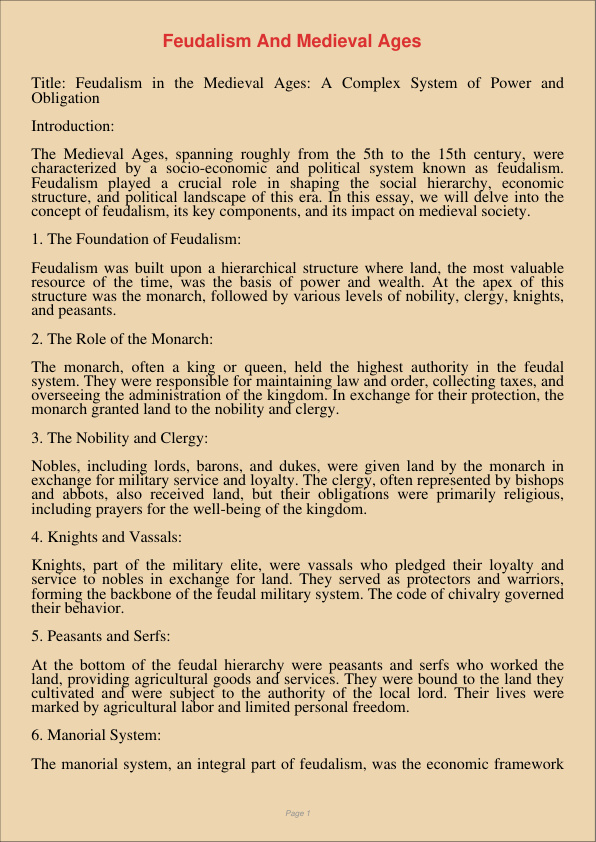Feudalism And Medieval Ages
Jan 7, 2024
medieval ages
feudalism
Gender & Sexual Studies
Geography

Title: Feudalism in the Medieval Ages: A Complex System of Power and Obligation
Introduction:
The Medieval Ages, spanning roughly from the 5th to the 15th century, were characterized by a socio-economic and political system known as feudalism. Feudalism played a crucial role in shaping the social hierarchy, economic structure, and political landscape of this era. In this essay, we will delve into the concept of feudalism, its key components, and its impact on medieval society.
- The Foundation of Feudalism:
Feudalism was built upon a hierarchical structure where land, the most valuable resource of the time, was the basis of power and wealth. At the apex of this structure was the monarch, followed by various levels of nobility, clergy, knights, and peasants.
- The Role of the Monarch:
The monarch, often a king or queen, held the highest authority in the feudal system. They were responsible for maintaining law and order, collecting taxes, and overseeing the administration of the kingdom. In exchange for their protection, the monarch granted land to the nobility and clergy.
- The Nobility and Clergy:
Nobles, including lords, barons, and dukes, were given land by the monarch in exchange for military service and loyalty. The clergy, often represented by bishops and abbots, also received land, but their obligations were primarily religious, including prayers for the well-being of the kingdom.
- Knights and Vassals:
Knights, part of the military elite, were vassals who pledged their loyalty and service to nobles in exchange for land. They served as protectors and warriors, forming the backbone of the feudal military system. The code of chivalry governed their behavior.
- Peasants and Serfs:
At the bottom of the feudal hierarchy were peasants and serfs who worked the land, providing agricultural goods and services. They were bound to the land they cultivated and were subject to the authority of the local lord. Their lives were marked by agricultural labor and limited personal freedom.
- Manorial System:
The manorial system, an integral part of feudalism, was the economic framework of the Middle Ages. Manors were self-sustaining agricultural estates, each governed by a lord. Peasants and serfs worked the land in exchange for protection and a portion of the harvest. The manor was the focal point of medieval life, with everything from agriculture to justice administered locally.
- Feudalism’s Decline:
Feudalism began to decline around the 14th and 15th centuries for several reasons, including changes in agricultural practices, urbanization, and the rise of centralized monarchies. The Black Death also disrupted the feudal system, leading to labor shortages and changes in the social and economic landscape.
Conclusion:
Feudalism, a complex system of power and obligation, defined the structure and dynamics of medieval society. It regulated the relationships between various classes and provided a framework for the distribution of land and resources. While it played a pivotal role in maintaining stability during a turbulent era, its decline paved the way for significant social, economic, and political changes that marked the transition from the Medieval Ages to the early modern period. Understanding feudalism is essential for comprehending the social and political evolution that shaped the course of European history.